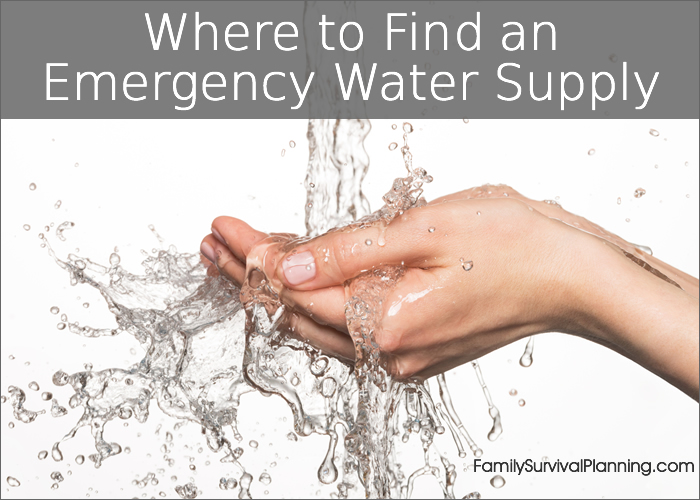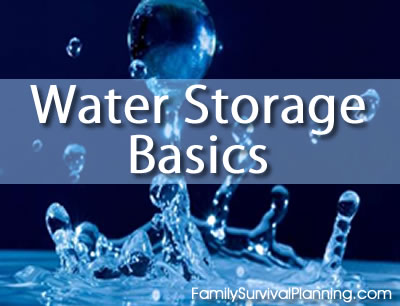- HOME
- Water Storage Basics
- Water Purification
4 Best Ways to Purify Water
- From Any Source

It is becoming necessary on a daily basis to learn water purification methods for safe drinking water in most parts of the world — and maybe even right out of your tap.
It's especially important in the event of a disaster.
If electrical power is non-existent due to a catastrophe, even tap water will not flow.
So it's important to know where to find water sources within your home as well as outside.
Invest in emergency food storage now and enjoy peace of mind for the next 25 years. Don't miss out on the savings!
Doing research in your area, find out:
- What sources are available outside of your home?
- How can you prepare to purify the water that comes from different sources?
Water Sources That Need Purifying
- well water (may need purification and usually needs electricity to run the pump)
- mountain streams
- lakes or reservoirs
- springs
- swimming pools and hot tubs
- old capped wells
- rainwater - Rainwater can be collected in some areas but is illegal in others (like Colorado). But don't assume that you can drink it as is - remember there are birds and insects living on the roof and their feces end up in the tank. It can, however, be an excellent source of water for watering the garden or flushing toilets.
Ways to Purify Water
There are several methods to purify water but it's an old wives' tale that beds of sand and gravel will do a good job of purifying water. The space between grains of sand is more than enough to let microscopic giardia lamblia parasites pass between them. (Trust me - you do NOT want giardia!)
Giardia and Cryptosporidium are two waterborne parasites that are often found in swimming pools and hot tubs as well as in rural settings. They are spread by human and animal feces and are hard to destroy.
Depending on the amount of water you want to filter or purify and the portability, the brands I have listed are some of the very best products available.
1. Gravity Flow Filters
Berkey Water Filters
Berkey Water Filters are a gravity flow system. I do love the taste of the water, but an important reason I bought a Berkey is because it has special filters for eliminating fluoride from the water. Fluoride is mandated by many states to be added to the drinking water supposedly to prevent cavities. But really, it is a poison that is harmful to the thyroid gland and possibly destroys brain cells.
Berkey water filter systems can
be classified as a water purifier because the elements actually remove
99.9999999% of pathogenic bacteria (log 9 reductions) and 99.999% of
viruses which greatly exceeds the standards. Check the water quality where you live and see how many contaminants are filtered out.
Want to know what's in your tap water? You might be shocked to find out. If you go to https://www.ewg.org/tapwater/ and put in your zip code you will see what has not been filtered out by your water company. Then you will know why you need a Berkey!
There are two types of filters that are available for most sizes of Berkeys. It comes with two "black" filters for filtering out all varieties of dangerous organisms and microscopic bacteria. The PF-2 filters are the fluoride filters (white).
There is a size for every need:
Crown Berkey - Holds 6 gallons.
Imperial Berkey - Holds 4.5 gallons.
Royal Berkey - Holds 3.25 gallons.
Berkey Light - Holds 2.75 gallons.
Big Berkey - Holds 2.25 gallons.
Travel Berkey - Compact Design, holds 1.5 gallons.
They are simple to use and can treat thousands of gallons of water without electricity, without plumbing, and without pressure or chemical pretreatments.
For a permanent residence, a good gravity flow filter is superior and much more convenient. They require no chemicals and since they operate by gravity, no pumping is required. They purify your water while you are free to do other things. There is a convenient tap on the bottom reservoir.
Alexapure Pro Water Filtration System
Alexapure Pro is a gravity-fed, stainless steel, water filtration system with a water capacity of 2.25 gallons (8.5 liters).
It has a filter capacity of up to 5,000 gallons and can use as many as 4 filters at once. The filters come pre-primed and remove 200+ contaminants, while preserving essential trace minerals. (The filters have been tested to NSF/ANSI Standards and use NSF/FDA approved materials. See independent lab tests here.)
Reduces up to 99.9999% of 206 contaminants, targeting:
- Heavy metals
- Lead
- Fluoride
- Chlorine
- Viruses & bacteria
- Pesticides & pharmaceuticals
The convenience of a gravity-fed water filtration system in times of crisis such as happened in Texas in the winter of 2020 when a "boil all water" warning was issued, cannot be stressed enough.
2. Small, Portable Filters
Since there are many poor quality filters on the market, make sure the product you purchase will filter protozoa, bacteria and viruses down to at least 0.5 microns. It should also be certified to EPA Guide Standards for microbiological purifiers against bacteria, cysts and viruses.
Survival Spring Personal Water Filter
Survival Spring Personal Water Filter by Alexapure (similar to LifeStraw) is a filtration system that makes 300 gallons of drinkable water out of just about any natural source.
Used like a straw, it purifies the water while you are drinking. Because of the three-stage filtration process that clears 99% of sediment and microorganisms, this personal filter makes water clean and safe for drinking from almost any natural water source.
LifeStraw Personal Water Filter
LifeStraw is perfect for 72-hour bags. It's small enough to tuck into your bag, back pocket or keep one in your car.
This amazing little personal water filter will filter 1,000 liters/264 gallons of water to 0.2 microns! It will remove 99.9999% of bacteria, like E. coli, etc., and 99.9% of protozoa like giardia and cryptosporidium.
It has a cap at the top to keep the drinking spout clean and a cap on the bottom which is removed while drinking and replaced to keep it from dripping after use.
Buy several and, like I said, keep some in your vehicles, in your 72-hour bags, or they make great gifts!
Grayl Purifier
The Grayl purifier and filter is just the right size to go into your emergency kit, take camping or backpacking, or take on vacations to foreign lands where water may not be safe to drink. Yet it's large enough to give you plenty of clean water with just one "press" that takes 8 seconds to produce purified water.
The purifier comes in two sizes, Geopress Purifier (24 ounces) and Ultralight Compact Purifier (16 ounces), and several different colors.
The filter cartridge is replaceable (after 350 uses/65 gallons). It removes 99.99% of viruses, bacteria, and protozoa, and filters out particulates (microplastics, sediment, silt), chemicals (chlorine, benzene, chloroform), as well as heavy metals (lead, arsenic, chromium).
This is one purifier/filter that will meet your needs for clean drinking water no matter where you are in the world.
Disclosure: I was given a Geopress Purifier by Grayl to test and try out. After using it for several weeks, I find the water from this purifier tastes fantastic (even though my husband says water has no taste). I can tell the difference because our tap water has too much chlorine in it and this purifier leaves no chlorine taste.
Katadyn Vario Microfilter

Katadyn is a very reputable brand (there are many different hand-pump filter brands) and I'm only reviewing it because I own one and love it. (It was not given to me for review purposes - I purchased it, then reviewed it.)
There are several sizes but most are small and light.
I was impressed with this water filtration system because of the three distinct filtering elements:
- a silver impregnated ceramic disk pre-filter
- a pleated glass fiber primary filter (0.3 microns)
- a replaceable carbon granulate core
It has two filtering "modes": fast flow and long life.
The long life mode uses all three filters, the ceramic, the glass fiber, and the carbon core to filter water that may have some solid particles or is muddy. The ceramic filter can be cleaned and reused over and over, while the other two filters must be replaced. The carbon filter should be replaced after filtering about 50 gallons.
Buy the best you can afford — this is not the item you should economize on. Learn to use the filters — they take a little practice. Don't forget to store extra replacement filters.
SteriPEN Water Purifier

The SteriPEN Adventurer Opti UV Water Purifier is an amazingly small and yet extremely effective water purifier.
These little purifiers have been proven to kill 99.9% of waterborne micro-organisms that cause illness using only UV light.
Perfect in size for slipping into a backpack for hiking or for permanent storage in your 72-hour bag.
Powered by 4 lithium or NiMH batteries (Alkaline & NiCd not recommended) you can get 200 treatments per set of batteries. How many hiking trips would that cover for you? Perfect!
3. Disinfecting Liquids and Tablets
Chlorine Dioxide Water Treatment
Chlorine dioxide is a well established disinfectant and is free of iodine and active chlorine. (Although chlorine dioxide has the word chlorine in its name, the two forms of chlorine have completely different chemical structures. The oxygen radically changes the molecule and creates completely different chemical behaviors and by-products.) They have a shelf life of 3-4 years, depending on the brand.
Chlorine Dioxide Water Treatment kills bacteria, viruses and cysts, including Giardia and Cryptosporidium.
Clorox or Chlorine Bleach
Common household chlorine bleach may be used to disinfect water in these amounts:
- 4 drops per quart gives 10 ppm in clear water (increase to 8 drops in cloudy water).
- 16 drops will provide 10 ppm per gallon of clear water.
You should be able to smell a slight odor of chlorine after the water sits for about 15 minutes. If not, add more chlorine. Chlorinated bleach loses its strength with time. It has a shelf life in storage of about 6 months at temps of 70 degrees or less. After one year on the shelf, it will have lost most of its strength and over time will become plain salt water. (Do not use scented bleach or bleach with additives.)
Having said that, most city water in the United States (I can't vouch for other countries) already contains chlorine. Because our water comes out of our taps with chlorine, it is not necessary to add chlorine to water you are putting into storage (See How to Store Water - Water Storage Myths). The chlorine in stored water, whether it comes from the tap or you put it into the water, will kill bacteria at first. But over time, the chlorine will break down into salt water which is no longer a disinfectant. If you're unsure of it's purity, boil it or run it through a Berkey or other purifying device.
It is also not necessary to rotate storage water, unless you just feel better doing it. Yes, after several years, it will smell or taste funny. That's because it lacks oxygen. Pour it back and forth between two containers to oxygenate and it will taste better. If you're unsure of it's purity, the best method to be sure is to boil it. But water will not rot like food — it is always just water.
WARNING: Chlorine or iodine will not reliably kill Giardia and Cryptosporidium. At colder temperatures, doubling or tripling the wait time will improve your chances. Boiling or chlorine dioxide tablets and good water filters are more reliable.
Iodine Tablets
One tablet added to a quart of water releases 8 ppm (parts per million) of iodine. Two tablets are used for cloudy water. Wait 15 minutes after adding tablets, 30 minutes if the water is cold. Iodine tables are NOT effective against Giardia and Cryptosporidium and can have adverse health effects on some people.
WARNING: Pregnant or nursing women or persons with thyroid problems should not drink water disinfected with iodine.
4. Disinfecting Water With Solar (SODIS)
Pour clean water into PET (PolyEthylene Terephthalate) bottles and expose to sunlight for a minimum of six hours if the sky is bright or up to 50% cloudy. If the sky is 50 to 100 percent overcast, the container needs to be exposed to the sun for two consecutive days. Plastic bottles made from PET or clear glass bottles are preferred. This method uses solar radiation and heat to destroy pathogenic microorganisms, which cause waterborne diseases.
Avoid the use of bottles made of PVC (PolyVinyl chloride). PVC bottles contain UV stabilizers, which blocks the sun's radiation. (PVC bottles often have a slight bluish color.)



















